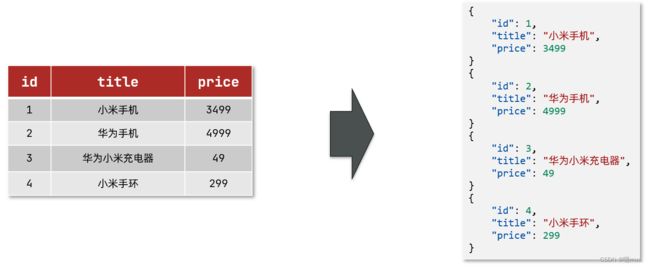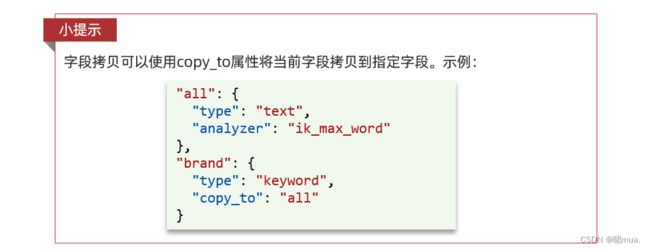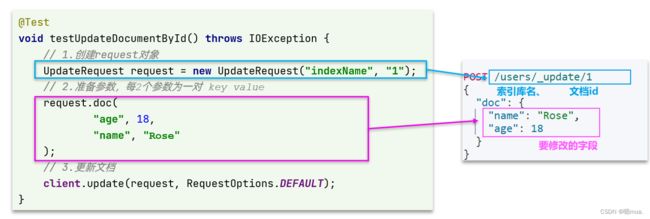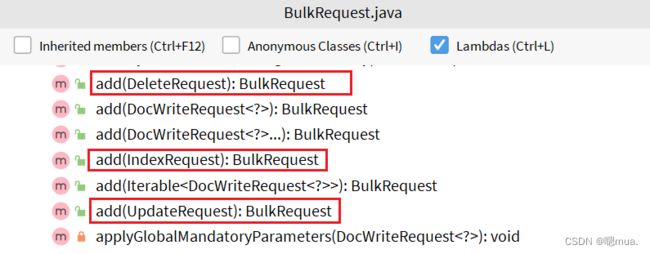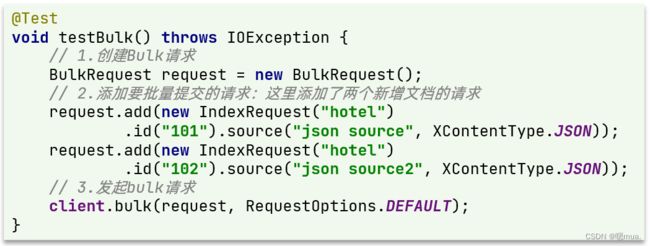【ElasticSearch】学习笔记(一)es的基本操作
【ElasticSearch】学习笔记(一)es的基本操作
文章目录
- 【ElasticSearch】学习笔记(一)es的基本操作
-
- 1. 基本概念
-
- 1.1 文档和字段
- 1.2 索引和映射
- 1.3 概念对比
- 1.4 分词器
- 1.5 mapping映射属性
- 2. 索引库的基本操作
-
- 2.1 创建索引库和映射
- 2.2 查询索引库
- 2.3 修改索引库
- 2.4 删除索引库
- 2.5 总结
- 3. 文档操作
-
- 3.1 新增文档
- 3.2 查询文档
-
- 3.2.1 查询所有文档
- 3.3 删除文档
- 3.3 修改文档
-
- 3.3.1 全量修改
- 3.3.2 增量修改
- 3.4 总结
- 4. RestAPI
-
- 4.1 准备工作
- 4.2 初始化RestClient
- 4.3 创建索引库
- 4.4 删除索引库
- 4.5 判断索引库是否存在
- 4.6 总结
- 5. RestClient操作文档
-
- 5.1 新增文档
- 5.2 查询文档
- 5.3 删除文档
- 5.4 修改文档
- 5.5 批量导入文档
- 5.6 总结
1. 基本概念
1.1 文档和字段
es是面向文档存储的,可以是数据库中的一条商品数据,一个订单信息。文档数据会被序列化为json格式后存储在es中。
Json文档中一般包含很多的字段,类似于数据库中的列。
1.2 索引和映射
索引:就是相同类型的文档的集合,类似与数据库中的表。
- 所有用户文档,就可以组织在一起,称为用户的索引;
- 所有商品的文档,可以组织在一起,称为商品的索引;
- 所有订单的文档,可以组织在一起,称为订单的索引;
映射:数据库的表会有约束信息,用来定义表的结构、字段的名称、类型等信息。因此,索引库中就有映射,是索引中文档的字段约束信息,类似表的结构约束。
1.3 概念对比
我们把mysql和es的概念做一下对比:
| MySQL | Elasticsearch | 说明 |
|---|---|---|
| Table | Index | 索引(index),就是文档的集合,类似数据库的表(table) |
| Row | Document | 文档(Document),就是一条条的数据,类似数据库中的行(Row),文档都是JSON格式 |
| Column | Field | 字段(Field),就是JSON文档中的字段,类似数据库中的列(Column) |
| Schema | Mapping | Mapping(映射)是索引中文档的约束,例如字段类型约束。类似数据库的表结构(Schema) |
| SQL | DSL | DSL是elasticsearch提供的JSON风格的请求语句,用来操作elasticsearch,实现CRUD |
es和mysql往往是相互补充的关系而不是相互替代的关系。
- mysql:擅长事务类型的操作,可以确保数据的安全性和一致性。
- es:擅长海量数据的搜索,分析,计算。
所以在企业中往往是两者结合使用:
- 对安全性要求较高的写操作,使用mysql实现
- 对查询性能要求较高的搜索需求,使用es实现
- 两者再基于某种方式,实现数据的同步,保证一致性
1.4 分词器
分词器的作用:
- 创建倒排索引时对文档分词
- 用户搜索时,对输入的内容分词
IK分词器(支持中文)有几种模式:
- ik_smart:智能切分,粗粒度
- ik_max_word:最细切分,细粒度
IK分词器拓展词条和停用词条:
- 在ik文件夹的config目录的
IKAnalyzer.xml文件中添加拓展词典和停用词典 - 在词典中添加拓展词条或停用词条
1.5 mapping映射属性
映射是对索引库中文档的约束,常见的映射属性如下所示:
- type:字段数据类型,常见的简单类型有:
- 字符串:text(可分词的文本)、keyword(精确值,例如:品牌、过假、IP地址)
- 数值:long、integer、short、byte、double、float
- 布尔:boolean
- 日期:date
- 对象:object
- index:是否创建索引,默认为true
- analyzer:使用哪种分词器
- properties:该字段的子字段
例如下面的json文档:
{
"age": 21,
"weight": 52.1,
"isMarried": false,
"info": "黑马程序员Java讲师",
"email": "[email protected]",
"score": [99.1, 99.5, 98.9],
"name": {
"firstName": "云",
"lastName": "赵"
}
}
对应的每个字段映射(mapping):
- age:类型为 integer;参与搜索,因此需要index为true;无需分词器
- weight:类型为float;参与搜索,因此需要index为true;无需分词器
- isMarried:类型为boolean;参与搜索,因此需要index为true;无需分词器
- info:类型为字符串,需要分词,因此是text;参与搜索,因此需要index为true;分词器可以用ik_smart
- email:类型为字符串,但是不需要分词,因此是keyword;不参与搜索,因此需要index为false;无需分词器
- score:虽然是数组,但是我们只看元素的类型,类型为float;参与搜索,因此需要index为true;无需分词器
- name:类型为object,需要定义多个子属性
- name.firstName;类型为字符串,但是不需要分词,因此是keyword;参与搜索,因此需要index为true;无需分词器
- name.lastName;类型为字符串,但是不需要分词,因此是keyword;参与搜索,因此需要index为true;无需分词器
2. 索引库的基本操作
采用DSL演示
2.1 创建索引库和映射
基本语法:
- 请求方式:PUT
- 请求路径:/索引库名(可自定义)
- 请求参数:mapping映射
格式:
PUT /索引库名称
{
"mappings": {
"properties": {
"字段名":{
"type": "text",
"analyzer": "ik_smart"
},
"字段名2":{
"type": "keyword",
"index": "false"
},
"字段名3":{
"properties": {
"子字段": {
"type": "keyword"
}
}
},
// ...略
}
}
}
实例:
#创建索引库
PUT /heima
{
"mappings": {
"properties": {
"info":{
"type": "text",
"analyzer": "ik_smart"
},
"email":{
"type": "keyword",
"index": false
},
"name":{
"type": "object",
"properties": {
"firstName":{
"type": "keyword"
},
"lastName":{
"type": "keyword"
}
}
}
}
}
}
2.2 查询索引库
基本语法:
- 请求方式:GET
- 请求路径:/索引库名
- 请求参数:无
格式:
GET /索引库名
示例:
#查询
GET /heima
2.3 修改索引库
倒排索引结构虽然不复杂,但是数据结构一旦改变(比如改变了分词器),就需要重新创建倒排索引,这简直是灾难。因此索引库一般创建就无法修改mapping。
虽然无法修改mapping中已有的字段,但是却可以添加新的字段到mapping中,因为这不会对倒排索引产生影响。
所以“修改索引库”实际上就是为索引库添加新字段。
基本语法:
- 请求方式:PUT
- 请求路径:/索引库名/_mapping
- 请求参数:有
格式即示例:
#修改(添加新字段)
put /heima/_mapping
{
"properties": {
"age":{
"type":"integer"
}
}
}
2.4 删除索引库
基本语法:
- 请求方式:DELETE
- 请求路径:/索引库名
- 请求参数:无
格式即示例:
#删除
DELETE /heima
2.5 总结
对索引库的操作:
- 创建索引库:PUT /索引库名
- 查询索引库:GET /索引库名
- 删除索引库:DELETE /索引库名
- 修改索引库(添加新字段):PUT /索引库名/_mapping
3. 文档操作
3.1 新增文档
语法:
POST /索引库名/_doc/文档id
{
"字段1": "值1",
"字段2": "值2",
"字段3": {
"子属性1": "值3",
"子属性2": "值4"
},
// ...
}
示例:
#新增文档
POST /heima/_doc/1
{
"info": "第一,绝不意气用事",
"email": "[email protected]",
"name": {
"firstName": "hj",
"lastName": "z"
}
}
3.2 查询文档
语法:
GET /索引库名/_doc/id
示例:
#查询
GET /heima/_doc/1
3.2.1 查询所有文档
语法:
GET /索引库名/_search
3.3 删除文档
语法:
DELETE /索引库名/_doc/id
示例:
#删除
DELETE /heima/_doc/1
3.3 修改文档
3.3.1 全量修改
**全量修改:**全量修改是直接覆盖原来的文档。
本质:
- 根据指定的id先删除文档
- 再新增一个相同id的文档
**注意:**如果根据id删除时,id不存在,第二步的新增操作依旧会执行,也就从修改变成了新增能操作。
简单来说就是“有则改之无则添加”。
语法:
PUT /索引库名/_doc/id
{
"字段1": "值1",
"字段2": "值2",
// ... 略
}
示例:
#全量修改文档
PUT /heima/_doc/1
{
"info": "第二,绝不漏判任何一件坏事",
"email": "[email protected]",
"name": {
"firstName": "hj",
"lastName": "z"
}
}
3.3.2 增量修改
**增量修改:**执行该指定id匹配的文档中的部分字段。
语法:
POST /索引库名/_update/id
{
"doc": {
"字段名": "新的值",
}
}
示例:
#局部修改文档字段
POST /heima/_update/1
{
"doc": {
"email": "[email protected]"
}
}
3.4 总结
文档操作:
- 创建文档:POST /索引库名/_doc/id { json文档 }
- 查询文档:GET /索引库名/_doc/id
- 删除文档:DELETE /索引库名/_doc/id
- 修改文档:
- 全量修改:PUT /索引库名/_doc/文档id { json文档 }
- 增量修改:POST /索引库名/_update/id { “doc”: {字段}}
4. RestAPI
4.1 准备工作
创建索引库,最关键的就是mapping映射,而mapping映射要考虑的信息包括:
- 字段名
- 字段数据类型
- 是否参与搜索
- 是否需要分词
- 如果分词,分词器是什么?
其中:
- 字段名、字段数据类型,可以参考数据表结构的名称和类型
- 是否参与搜索要分析业务来判断,例如图片地址,就无需参与搜索
- 是否分词呢要看内容,内容如果是一个整体就无需分词,反之则要分词
- 分词器,我们可以统一使用ik_max_word
来看下酒店数据的索引库结构:
PUT /hotel
{
"mappings": {
"properties": {
"id": {
"type": "keyword"
},
"name":{
"type": "text",
"analyzer": "ik_max_word",
"copy_to": "all"
},
"address":{
"type": "keyword",
"index": false
},
"price":{
"type": "integer"
},
"score":{
"type": "integer"
},
"brand":{
"type": "keyword",
"copy_to": "all"
},
"city":{
"type": "keyword",
"copy_to": "all"
},
"starName":{
"type": "keyword"
},
"business":{
"type": "keyword"
},
"location":{
"type": "geo_point"
},
"pic":{
"type": "keyword",
"index": false
},
"all":{
"type": "text",
"analyzer": "ik_max_word"
}
}
}
}
几个特殊字段说明:
- location:地理坐标,里面包含精度、纬度
- all:一个组合字段,其目的是将多字段的值 利用copy_to合并,提供给用户搜索
地理坐标说明:
copy_to说明:
4.2 初始化RestClient
1)引入es的RestHighLevelClient依赖:
由于SpringBoot默认的es版本是7.6.2,所以我们需要覆盖的es版本:
<dependency>
<groupId>org.elasticsearch.clientgroupId>
<artifactId>elasticsearch-rest-high-level-clientartifactId>
<version>7.12.1version>
dependency>
2)初始化RestHighLevelClient:
编写测试方法,测试连接是否成功:
public class HotelIndexTest {
private RestHighLevelClient client;
@Test
void testInit() {
System.out.println(client);
}
@BeforeEach
void setUp() {
this.client=new RestHighLevelClient(RestClient.builder(
HttpHost.create("http://127.0.0.1:9200")
));
}
@AfterEach
void tearDown() throws IOException {
this.client.close();
}
}
4.3 创建索引库
创建索引库的API如下:
代码分为三步:
- 1)创建Request对象。因为是创建索引库的操作,因此Request是CreateIndexRequest。
- 2)添加请求参数,其实就是DSL的JSON参数部分。因为json字符串很长,这里是定义了静态字符串常量MAPPING_TEMPLATE,让代码看起来更加优雅。
- 3)发送请求,client.indices()方法的返回值是IndicesClient类型,封装了所有与索引库操作有关的方法。
示例:
在常量类中定义一个dsl语句:
public class HotelConstants {
public static final String MAPPING_TEMPLATE="{\n" +
" \"mappings\": {\n" +
" \"properties\": {\n" +
" \"id\": {\n" +
" \"type\": \"keyword\"\n" +
" },\n" +
" \"name\":{\n" +
" \"type\": \"text\",\n" +
" \"analyzer\": \"ik_max_word\",\n" +
" \"copy_to\": \"all\"\n" +
" },\n" +
" \"address\":{\n" +
" \"type\": \"keyword\",\n" +
" \"index\": false\n" +
" },\n" +
" \"price\":{\n" +
" \"type\": \"integer\"\n" +
" },\n" +
" \"score\":{\n" +
" \"type\": \"integer\"\n" +
" },\n" +
" \"brand\":{\n" +
" \"type\": \"keyword\",\n" +
" \"copy_to\": \"all\"\n" +
" },\n" +
" \"city\":{\n" +
" \"type\": \"keyword\",\n" +
" \"copy_to\": \"all\"\n" +
" },\n" +
" \"starName\":{\n" +
" \"type\": \"keyword\"\n" +
" },\n" +
" \"business\":{\n" +
" \"type\": \"keyword\"\n" +
" },\n" +
" \"location\":{\n" +
" \"type\": \"geo_point\"\n" +
" },\n" +
" \"pic\":{\n" +
" \"type\": \"keyword\",\n" +
" \"index\": false\n" +
" },\n" +
" \"all\":{\n" +
" \"type\": \"text\",\n" +
" \"analyzer\": \"ik_max_word\"\n" +
" }\n" +
" }\n" +
" }\n" +
"}";
}
然后在测试类中编写测试方法,实现创建索引的操作:
@Test
void createHotelIndex() throws IOException {
//1.创建Request对象
CreateIndexRequest request = new CreateIndexRequest("hotel");
//2.准备请求的参数:DSL语句
request.source(MAPPING_TEMPLATE, XContentType.JSON);
//3.发送请求
client.indices().create(request, RequestOptions.DEFAULT);
}
4.4 删除索引库
与创建索引库相比:
- 请求方式从PUT变为DELETE
- 请求路径不变
- 无请求参数
删除代码主要体现在Request对象上:
- 创建request对象,这次是DeleteIndexRequest对象
- 准备参数。这里是无参
- 发送请求,改用delete方法
编写测试方法,删除索引库:
//删除索引库
@Test
void testDeleteHotelIndex() throws IOException {
//1.创建Request对象
DeleteIndexRequest request = new DeleteIndexRequest("hotel");
//2.发送请求
client.indices().delete(request, RequestOptions.DEFAULT);
}
4.5 判断索引库是否存在
判断索引库是否存在本质上就是查询操作。
因此与删除的Java代码流程是类似的。依然是三步走:
- 1)创建Request对象。这次是GetIndexRequest对象
- 2)准备参数。这里是无参
- 3)发送请求。改用exists方法
代码如下:
//判断索引库是否存在
@Test
void testExistHotelIndex() throws IOException {
//1.创建Request对象
GetIndexRequest request = new GetIndexRequest("hotel");
//2.发送请求
boolean exists = client.indices().exists(request, RequestOptions.DEFAULT);
//3.输出
System.out.println(exists ? "存在" : "不存在");
}
4.6 总结
JavaRestClient操作elasticsearch的流程基本类似。核心是client.indices()方法来获取索引库的操作对象。
索引库操作的基本步骤:
- 初始化RestHighLevelClient
- 创建XxxIndexRequest。XXX是Create、Get、Delete
- 准备DSL( Create时需要,其它是无参)
- 发送请求。调用RestHighLevelClient#indices().xxx()方法,xxx是create、exists、delete
5. RestClient操作文档
5.1 新增文档
需求:
将数据库中的酒店信息查询出来写入es中。
思路:
我们导入酒店数据,基本流程一致,但是需要考虑几点变化:
- 酒店数据来自于数据库,我们需要先查询出来,得到hotel对象
- hotel对象需要转为HotelDoc对象
- HotelDoc需要序列化为json格式
因此,代码整体步骤如下:
- 1)根据id查询酒店数据Hotel
- 2)将Hotel封装为HotelDoc
- 3)将HotelDoc序列化为JSON
- 4)创建IndexRequest,指定索引库名和id
- 5)准备请求参数,也就是JSON文档
- 6)发送请求
实现:
在测试类中编写一个测试方法:
@Test
void testAddDocument() throws IOException {
//根据id查询酒店数据
Hotel hotel = hotelService.getById(36934l);
//转换为文档类型
HotelDoc hotelDoc = new HotelDoc(hotel);
//1.准备Request对象
IndexRequest request = new IndexRequest("hotel").id(hotel.getId().toString());
//2.准备Json文档
request.source(JSON.toJSONString(hotelDoc), XContentType.JSON);
//3.发送请求
client.index(request, RequestOptions.DEFAULT);
}
5.2 查询文档
与之前类似,也是三步走:
- 准备Request对象。这次是查询,所以是GetRequest
- 发送请求,得到结果。因为是查询,这里调用client.get()方法
- 解析结果,就是对JSON做反序列化
//查询文档
@Test
void testGetDocumentById() throws IOException {
//1.准备Request对象
GetRequest request = new GetRequest("hotel", "36934");
//2.发送请求
GetResponse response = client.get(request, RequestOptions.DEFAULT);
//3.解析结果
String json = response.getSourceAsString();
HotelDoc hotelDoc = JSON.parseObject(json, HotelDoc.class);
System.out.println(hotelDoc);
}
5.3 删除文档
与查询相比,删除操作仅仅是请求方式从GET变成DELETE,可以想象Java代码应该依然是三步走:
- 1)准备Request对象,因为是删除,这次是DeleteRequest对象。要指定索引库名和id
- 2)准备参数,无参
- 3)发送请求。因为是删除,所以是client.delete()方法
在测试类中编写一个测试方法:
//删除文档
@Test
void testDeleteDocument() throws IOException {
//1.准备request
DeleteRequest request = new DeleteRequest("hotel", "36934");
//2.发送请求
client.delete(request,RequestOptions.DEFAULT);
}
5.4 修改文档
在RestClient的API中,全量修改和新增的API完全一致,判断依据是id:
- 如果新增时,id已经存在,则修改
- 如果新增时,id不存在,则新增
所以这里的修改操作只有增量修改。
代码示例如下图:
与之前类似,也是三步走:
- 1)准备Request对象。这次是修改,所以是UpdateRequest
- 2)准备参数。也就是JSON文档,里面包含要修改的字段
- 3)更新文档。这里调用client.update()方法
在测试类中编写测试方法:
//修改文档
@Test
void testUpdateDocument() throws IOException {
//1.准备Request
UpdateRequest request = new UpdateRequest("hotel", "36934");
//2.准备请求参数
request.doc(
"price","350",
"starName","三钻"
);
//3.发送请求
client.update(request,RequestOptions.DEFAULT);
}
5.5 批量导入文档
需求:
将所有的酒店数据导入到索引库中。
思路:
-
利用mybatis-plus查询酒店数据
-
将查询到的酒店数据(Hotel)转换为文档类型数据(HotelDoc)
-
利用JavaRestClient中的BulkRequest批处理,实现批量新增文档
批量处理的本质就是将多个普通的crud请求组合在一起发送。
其中提供了一个add方法,用来添加其他请求:
可以看到,能添加的请求包括:
- IndexRequest,也就是新增
- UpdateRequest,也就是修改
- DeleteRequest,也就是删除
所以Bulk中添加了多个IndexRequest,就是批量新增功能了。示例图如下:
在测试类中编写测试方法,代码示例如下:
//批量导入文档
@Test
void testBulkRequest() throws IOException {
//批量查询酒店数据
List<Hotel> hotels = hotelService.list();
//1.创建Request
BulkRequest request = new BulkRequest();
//2.准备参数,添加多个新增的request
for (Hotel hotel : hotels) {
HotelDoc hotelDoc = new HotelDoc(hotel);
request.add(new IndexRequest("hotel")
.id(hotelDoc.getId().toString())
.source(JSON.toJSONString(hotelDoc), XContentType.JSON));
}
//3.发送请求
client.bulk(request, RequestOptions.DEFAULT);
}
5.6 总结
文档操作的基本步骤:
- 初始化RestHighLevelClient
- 创建XxxRequest。XXX是Index、Get、Update、Delete、Bulk
- 准备参数(Index、Update、Bulk时需要)
- 发送请求。调用RestHighLevelClient#.xxx()方法,xxx是index、get、update、delete、bulk
- 解析结果(Get时需要)
文档操作和索引库操作的区别:
- 文档操作的Request为XXXRequest,而索引库操作的是XXXIndexRequest
- 文档操作发送请求直接是
client.xxx(),而索引库操作的是client.indices().xxx()
